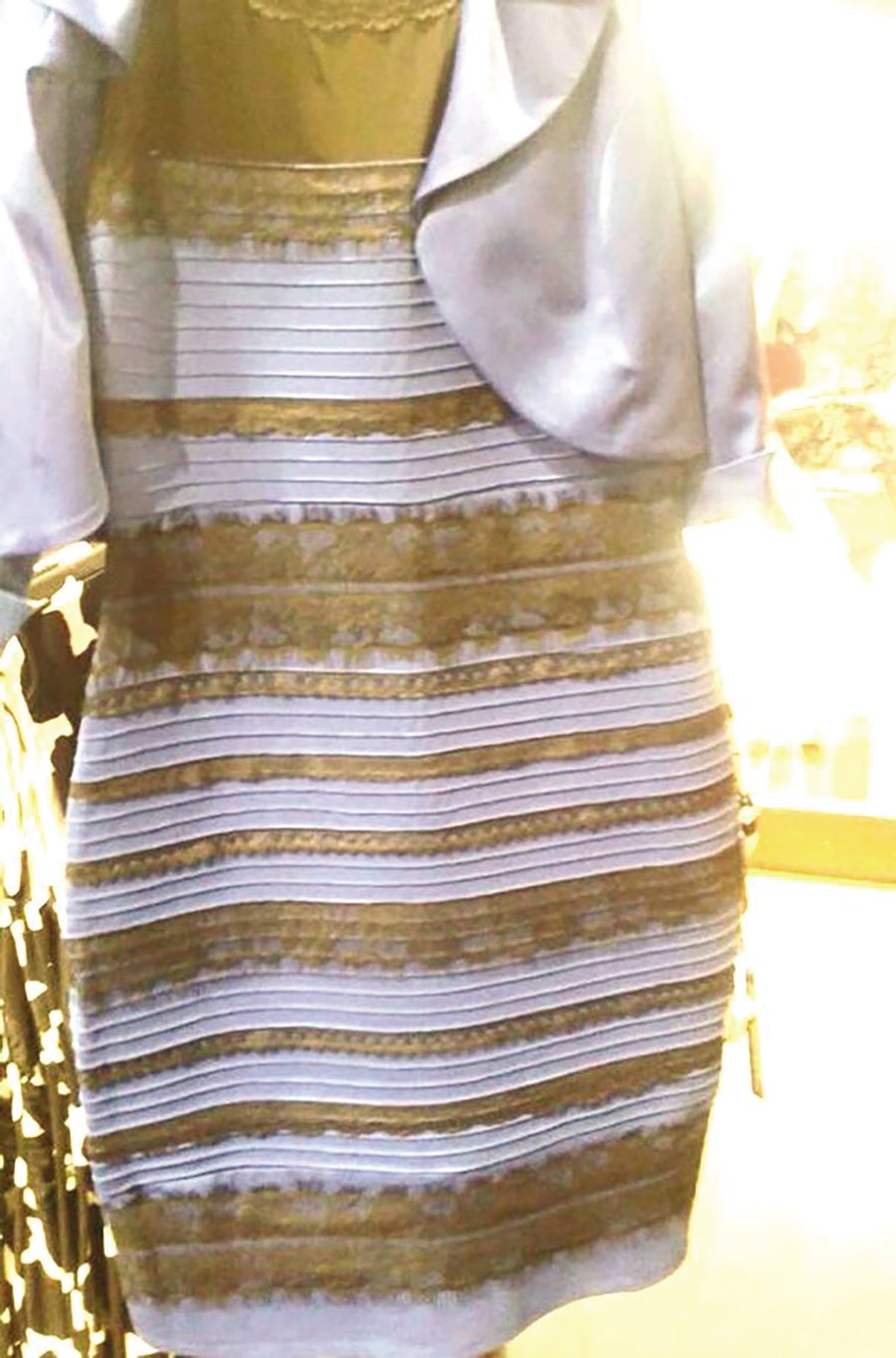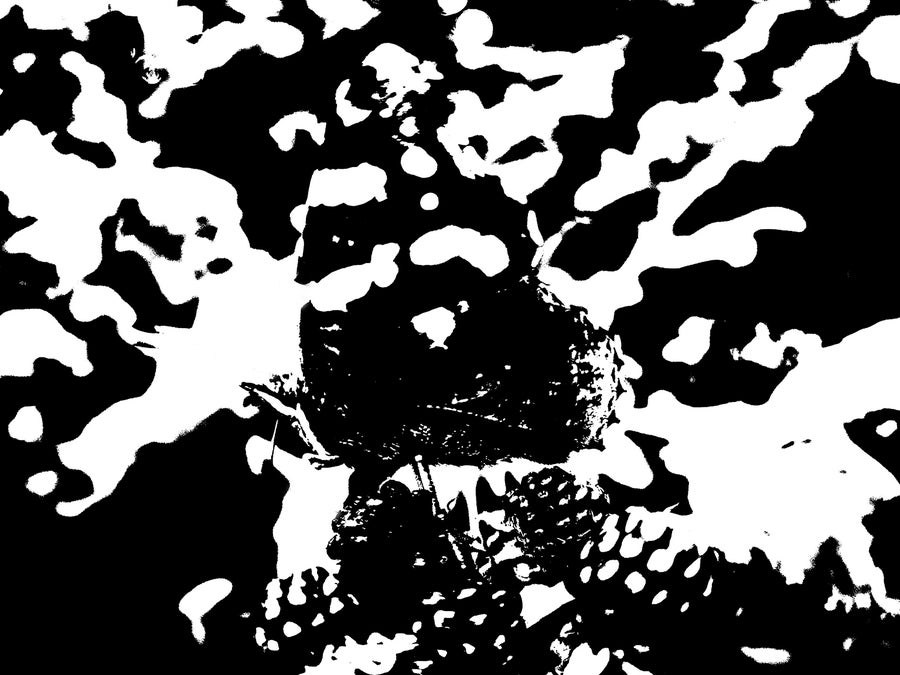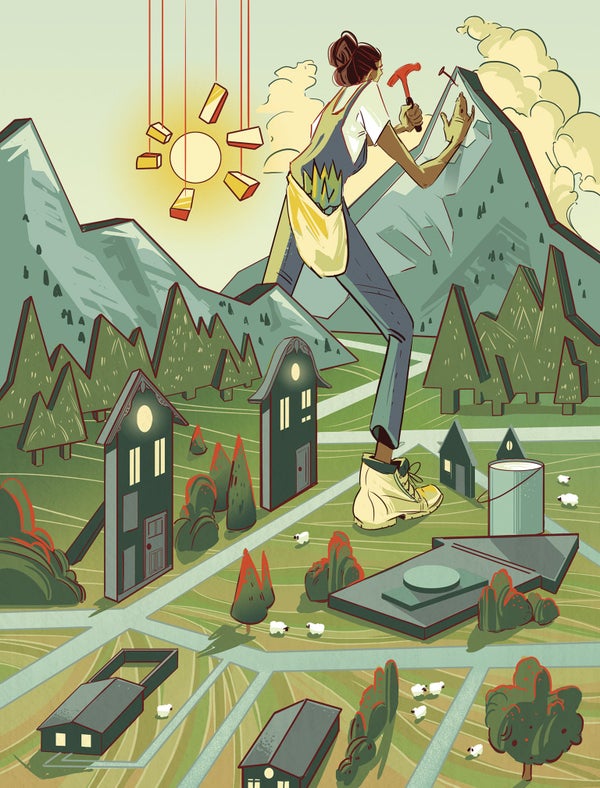“We do not see things as they are, we see them as we are.”
—from Seduction of the Minotaur, by Anaïs Nin (1961)
On the 10th of April 2019 Pope Francis, President Salva Kiir of South Sudan and former rebel leader Riek Machar sat down together for dinner at the Vatican. They ate in silence, the start of a two-day retreat aimed at reconciliation from a civil war that had killed some 400,000 people since 2013. At about the same time in my laboratory at the University of Sussex in England, Ph.D. student Alberto Mariola was starting to work on an experiment in which volunteers experience being in a room they believe is there but is not. In psychiatry clinics across the globe, people arrive complaining that things no longer seem “real” to them, whether it is the world around them or their own selves. In the fractured societies in which we live, what is real—and what is not—seems to be increasingly up for grabs. Warring sides may experience and believe in different realities. Perhaps eating together in silence can help because it offers a small slice of reality that can be agreed on, a stable platform on which to build further understanding.
On supporting science journalism
If you're enjoying this article, consider supporting our award-winning journalism by subscribing. By purchasing a subscription you are helping to ensure the future of impactful stories about the discoveries and ideas shaping our world today.
We need not look to war and psychosis to find radically different inner universes. In 2015 a badly exposed photograph of a dress tore across the Internet, dividing the world into those who saw it as blue and black (me included) and those who saw it as white and gold (half my lab). Those who saw it one way were so convinced they were right—that the dress truly was blue and black or white and gold—that they found it almost impossible to believe that others might perceive it differently.

Poorly exposed photograph of a dress appears blue and black to some people, white and gold to others. Credit: Swiked.tumblr.com
We all know that our perceptual systems are easy to fool. The popularity of visual illusions is testament to this phenomenon. Things seem to be one way, and they are revealed to be another: two lines appear to be different lengths, but when measured they are exactly the same; we see movement in an image we know to be still. The story usually told about illusions is that they exploit quirks in the circuitry of perception, so that what we perceive deviates from what is there. Implicit in this story, however, is the assumption that a properly functioning perceptual system will render to our consciousness things precisely as they are.
The deeper truth is that perception is never a direct window onto an objective reality. All our perceptions are active constructions, brain-based best guesses at the nature of a world that is forever obscured behind a sensory veil. Visual illusions are fractures in the Matrix, fleeting glimpses into this deeper truth.
Take, for example, the experience of color—say, the bright red of the coffee mug on my desk. The mug really does seem to be red: its redness seems as real as its roundness and its solidity. These features of my experience seem to be truly existent properties of the world, detected by our senses and revealed to our mind through the complex mechanisms of perception.
Yet we have known since Isaac Newton that colors do not exist out there in the world. Instead they are cooked up by the brain from mixtures of different wavelengths of colorless electromagnetic radiation. Colors are a clever trick that evolution has hit on to help the brain keep track of surfaces under changing lighting conditions. And we humans can sense only a tiny slice of the full electromagnetic spectrum, nestled between the lows of infrared and the highs of ultraviolet. Every color we perceive, every part of the totality of each of our visual worlds, comes from this thin slice of reality.
Just knowing this is enough to tell us that perceptual experience cannot be a comprehensive representation of an external objective world. It is both less than that and more than that. The reality we experience—the way things seem—is not a direct reflection of what is actually out there. It is a clever construction by the brain, for the brain. And if my brain is different from your brain, my reality may be different from yours, too.
The Predictive Brain
In Plato's Allegory of the Cave, prisoners are chained to a blank wall all their lives, so that they see only the play of shadows cast by objects passing by a fire behind them, and they give the shadows names because for them the shadows are what is real. A thousand years later, but still a thousand years ago, Arabian scholar Ibn al-Haytham wrote that perception, in the here and now, depends on processes of “judgment and inference” rather than involving direct access to an objective reality. Hundreds of years later again Immanuel Kant realized that the chaos of unrestricted sensory data would always remain meaningless without being given structure by preexisting conceptions or “beliefs,” which for him included a priori frameworks such as space and time. Kant's term “noumenon” refers to a “thing in itself”—Ding an sich—an objective reality that will always be inaccessible to human perception.
Today these ideas have gained a new momentum through an influential collection of theories that turn on the idea that the brain is a kind of prediction machine and that perception of the world—and of the self within it—is a process of brain-based predictions about the causes of sensory signals.
These new theories are usually traced to German physicist and physiologist Hermann von Helmholtz, who in the late 19th century proposed that perception is a process of unconscious inference. Toward the end of the 20th century Helmholtz's notion was taken up by cognitive scientists and artificial-intelligence researchers, who reformulated it in terms of what is now generally known as predictive coding or predictive processing.
The central idea of predictive perception is that the brain is attempting to figure out what is out there in the world (or in here, in the body) by continually making and updating best guesses about the causes of its sensory inputs. It forms these best guesses by combining prior expectations or “beliefs” about the world, together with incoming sensory data, in a way that takes into account how reliable the sensory signals are. Scientists usually conceive of this process as a form of Bayesian inference, a framework that specifies how to update beliefs or best guesses with new data when both are laden with uncertainty.
In theories of predictive perception, the brain approximates this kind of Bayesian inference by continually generating predictions about sensory signals and comparing these predictions with the sensory signals that arrive at the eyes and the ears (and the nose and the fingertips and all the other sensory surfaces on the outside and inside of the body). The differences between predicted and actual sensory signals give rise to so-called prediction errors, which are used by the brain to update its predictions, readying it for the next round of sensory inputs. By striving to minimize sensory-prediction errors everywhere and all the time, the brain implements approximate Bayesian inference, and the resulting Bayesian best guess is what we perceive.
To understand how dramatically this perspective shifts our intuitions about the neurological basis of perception, it is helpful to think in terms of bottom-up and top-down directions of signal flow in the brain. If we assume that perception is a direct window onto an external reality, then it is natural to think that the content of perception is carried by bottom-up signals—those that flow from the sensory surfaces inward. Top-down signals might contextualize or finesse what is perceived, but nothing more. Call this the “how things seem” view because it seems as if the world is revealing itself to us directly through our senses.
The prediction machine scenario is very different. Here the heavy lifting of perception is performed by the top-down signals that convey perceptual predictions, with the bottom-up sensory flow serving only to calibrate these predictions, keeping them yoked, in some appropriate way, to their causes in the world. In this view, our perceptions come from the inside out just as much as, if not more than, from the outside in. Rather than being a passive registration of an external objective reality, perception emerges as a process of active construction—a controlled hallucination, as it has come to be known.
Why controlled hallucination? People tend to think of hallucination as a kind of false perception, in clear contrast to veridical, true-to-reality, normal perception. The prediction machine view suggests instead a continuity between hallucination and normal perception. Both depend on an interaction between top-down, brain-based predictions and bottom-up sensory data, but during hallucinations, sensory signals no longer keep these top-down predictions appropriately tied to their causes in the world. What we call hallucination, then, is just a form of uncontrolled perception, just as normal perception is a controlled form of hallucination.
This view of perception does not mean that nothing is real. Writing in the 17th century, English philosopher John Locke made an influential distinction between “primary” and “secondary” qualities. Primary qualities of an object, such as solidity and occupancy of space, exist independently of a perceiver. Secondary qualities, in contrast, exist only in relation to a perceiver—color is a good example. This distinction explains why conceiving of perception as controlled hallucination does not mean it is okay to jump in front of a bus. The bus has primary qualities of solidity and space occupancy that exist independently of our perceptual machinery and that can do us injury. It is the way in which the bus appears to us that is a controlled hallucination, not the bus itself.
Tripping in the Lab
A growing body of evidence supports the idea that perception is controlled hallucination, at least in its broad outlines. A 2015 study by Christoph Teufel of Cardiff University in Wales and his colleagues offers a striking example. In this study, the ability to recognize so-called two-tone images was evaluated in patients with early-stage psychosis who were prone to hallucinations.
Take a look at the photograph below—a sample of a two-tone image. Probably all you will see is a bunch of black-and-white splotches. Now look at the second image below. Then have another look at the first photo; it ought to look rather different. Where previously there was a splotchy mess, there are now distinct objects, and something is happening.

Two-tone image looks like a mess of black-and-white splotches until you see the full image below. Credit: Richard Armstrong/EyeEm/Getty Images
What I find remarkable about this exercise is that in your second examination of the first image, the sensory signals arriving at your eyes have not changed at all from the first time you saw it. All that has changed are your brain's predictions about the causes of these sensory signals. You have acquired a new high-level perceptual expectation, and this changes what you consciously see.

Perceptual shift: Viewing this photograph changes what one consciously sees in the two-tone image above. Credit: Richard Armstrong/EyeEm/Getty Images
If you show people many two-tone images, each followed by the full picture, they might subsequently be able to identify a good proportion of two-tone images, though not all of them. In Teufel's study, people with early-stage psychosis were better at recognizing two-tone images after having seen the full image than were healthy control subjects. In other words, being hallucination-prone went along with perceptual priors having a stronger effect on perception. This is exactly what would be expected if hallucinations in psychosis depended on an overweighting of perceptual priors so that they overwhelmed sensory-prediction errors, unmooring perceptual best guesses from their causes in the world.
Recent research has revealed more of this story. In a 2021 study, Biyu He of New York University and her colleagues had neurosurgical patients look at ambiguous images, such as a Necker cube, that constantly flip between two different appearances even though the sensory input remains the same. By analyzing the signals recorded from within the patients' brains, they discovered that information flowed more strongly in a top-down, “inside-out” direction when the perceived appearance was consistent with the patients' biases, as would be expected if perceptual predictions were strong in this case. And when the perceived appearance was inconsistent with preexisting biases, information flow was stronger in the bottom-up direction, suggesting a “prediction error” signal. This is an exciting new development in mapping the brain basis of controlled hallucinations.
In my lab we have taken a different approach to exploring the nature of perception and hallucination. Rather than looking into the brain directly, we decided to simulate the influence of overactive perceptual priors using a unique virtual-reality setup masterminded by VR guru Keisuke Suzuki. We call it, with tongue firmly in cheek, the “hallucination machine.”
Using a 360-degree camera, we first recorded panoramic video footage of a busy square in the University of Sussex campus on a Tuesday at lunchtime. We then processed the footage through an algorithm based on Google's AI program DeepDream to generate a simulated hallucination. What happens is that the algorithm takes a so-called neural network—one of the workhorses of AI—and runs it backward. The network we used had been trained to recognize objects in images, so if you run it backward, updating the network's input instead of its output, the network effectively projects what it “thinks” is there onto and into the image. Its predictions overwhelm the sensory inputs, tipping the balance of perceptual best guessing toward these predictions. Our particular network was good at classifying different breeds of dogs, so the video became unusually suffused with dog presences.
Many people who have viewed the processed footage through the VR headset have commented that the experience is rather reminiscent not of the hallucinations of psychosis but of the exuberant phenomenology of psychedelic trips.
More recently, we have implemented the hallucination machine in different ways to simulate different kinds of altered visual experience. By extending our algorithm to include two coupled neural networks—a “discriminator network” much like the one in our original study and a “generator network” that has been trained to reproduce (“generate”) its input image—we have been able to model different types of hallucination. For example, we have modeled the complex hallucinatory experiences reported by people with Parkinson's disease and some forms of dementia; the patterned, geometric hallucinations that occur after the loss of foveal vision, as happens in Charles Bonnet syndrome; and a range of psychedeliclike hallucinations. We hope that by understanding hallucinations better, we will be able to understand normal experience better, too, because predictive perception is at the root of all our perceptual experience.
The Perception of Reality
Although the hallucination machine is undoubtedly trippy, people who experience it are fully aware that what they are experiencing is not real. Indeed, despite rapid advances in VR technology and computer graphics, no current VR setup delivers an experience sufficiently convincing to be indistinguishable from reality.
This is the challenge we took up when designing a new “substitutional reality” setup at Sussex—the one we were working on when Pope Francis convened the retreat with Salva Kiir and Riek Machar. Our aim was to create a system in which volunteers would experience an environment as being real—and believe it to be real—when in fact it was not real.
The basic idea is simple. We again prerecorded some panoramic video footage, this time of the interior of our VR lab rather than of an outside campus scene. People coming to the lab are invited to sit on a stool in the middle of the room and to put on a VR headset that has a camera attached to the front. They are encouraged to look around the room and to see the room as it actually is, via the camera. At some point, without telling them, we switch the feed so that the headset displays not the live real-world scene but rather the prerecorded panoramic video. Most people in this situation continue to experience what they are seeing as real even though it is now a fake prerecording. (This is actually very tricky to pull off in practice—it requires careful color balancing and alignment to avoid people noticing any difference that would tip them off to the shift.)
I find this result fascinating because it shows that it is possible to have people experience an unreal environment as being fully real. This demonstration alone opens new frontiers for VR research: we can test the limits of what people will experience, and believe, to be real. It also allows us to investigate how experiencing things as being real can affect other aspects of perception. In one of our most recent experiments, we aimed to find out whether people are worse at detecting unexpected changes in the room when they believe that what they are experiencing is real. If things do turn out this way (the study was heavily delayed by the global pandemic), that finding would support the idea that the perception of things as being real itself acts as a high-level prior that can substantively shape our perceptual best guesses, affecting the contents of what we perceive.
The Reality of Reality
The idea that the world of our experience might not be real is an enduring trope of philosophy and science fiction, as well as of late-night pub discussions. Neo in The Matrix takes the red pill, and Morpheus shows him how what he thought was real is an elaborate simulation, while the real Neo lies prone in a human body farm, a brain-in-a-vat power source for a dystopian AI. Philosopher Nick Bostrom of the University of Oxford has famously argued, based largely on statistics, that we are likely to be living inside a computer simulation created in a posthuman age. I disagree with this argument in part because it assumes that consciousness can be simulated—I do not think that this is a safe assumption—but it is thought-provoking nonetheless.
Although these chunky metaphysical topics are fun to chew on, they are probably impossible to resolve. Instead what we have been exploring throughout this article is the relation between appearance and reality in our conscious perceptions, where part of this appearance is the appearance of being real itself.
The central idea here is that perception is a process of active interpretation geared toward adaptive interaction with the world via the body rather than a re-creation of the world within the mind. The contents of our perceptual worlds are controlled hallucinations, brain-based best guesses about the ultimately unknowable causes of sensory signals. For most of us, most of the time, these hallucinations are experienced as real. As Canadian rapper and science communicator Baba Brinkman suggested to me, when we agree about our hallucinations, maybe that's what we call reality.
But we do not always agree, and we do not always experience things as real. People with dissociative psychiatric conditions such as derealization or depersonalization syndrome report that their perceptual worlds, even their own selves, lack a sense of reality. Some kinds of hallucination, various psychedelic hallucinations among them, combine a sense of unreality with perceptual vividness, as does lucid dreaming. People with synesthesia consistently have additional sensory experiences, such as perceiving colors when viewing black letters, which they recognize as not real. Even with normal perception, if you look directly at the sun you will experience the subsequent retinal afterimage as not being real. There are many such ways in which we experience our perceptions as not fully real.
What this means to me is that the property of realness that attends most of our perceptions should not be taken for granted. It is another aspect of the way our brain settles on its Bayesian best guesses about its sensory causes. One might thus ask what purpose it serves. Perhaps the answer is that a perceptual best guess that includes the property of being real is usually more fit for purpose—that is, better able to guide behavior—than one that does not. We will behave more appropriately with respect to a coffee cup, an approaching bus or our partner's mental state when we experience it as really existing.
But there is a trade-off. As illustrated by the dress illusion, when we experience things as being real, we are less able to appreciate that our perceptual worlds may differ from those of others. (A popular explanation for the differing perceptions of the garment holds that people who spend most of their waking hours in daylight see it as white and gold; night owls, who are mainly exposed to artificial light, see it as blue and black.) And even if these differences start out small, they can become entrenched and reinforced as we proceed to harvest information differently, selecting sensory data that are best aligned with our individual emerging models of the world and then updating our perceptual models based on these biased data. We are all familiar with this process from the echo chambers of social media and the newspapers we choose to read. I am suggesting that the same principles apply also at a deeper level, underneath our sociopolitical beliefs, right down to the fabric of our perceptual realities. They may even apply to our perception of being a self—the experience of being me or of being you—because the experience of being a self is itself a perception.
This is why understanding the constructive, creative mechanisms of perception has unexpected social relevance. Perhaps once we can appreciate the diversity of experienced realities scattered among the billions of perceiving brains on this planet, we will find new platforms on which to build a shared understanding and a better future—whether between sides in a civil war, followers of different political parties, or two people sharing a house and faced with washing the dishes.
